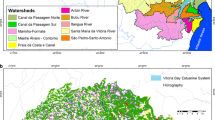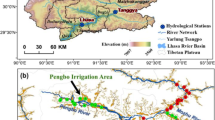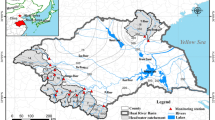Abstract
The Northeastern semi-arid Brazilian region is experiencing rapid social and economic development based on improving water management and even in areas of low human occupation, anthropogenic emissions of N and P surpass natural emissions in at least one order of magnitude and these additional loads can alter the water quality of the receiving estuaries. This study estimates, using an emission factor approach, the annual emissions of N and P from natural processes and anthropogenic sources for estuaries along the Ceará State, NE Brazil. Emission factors from natural sources are one to two orders of magnitude lower than those for anthropogenic sources. Among the anthropogenic activities, the aquaculture is responsible for most N emission (0.52 t km−2 year−1) followed by waste water and husbandry. For P, the largest average emission factors are from husbandry (0.30 t km−2 year−1), waste water and agriculture.
Similar content being viewed by others
References
ABCC (Associação Brasileira dos Criadores de Camarão) (2003). Censo da produção do camarão marinho cultivado. Recife: ABCC.
ABES (Associação Brasileira de Engenharia Sanitária e Ambiental) (1983). Catálogo Brasileiro de Engenharia Sanitária (p. 127). Rio de Janeiro: ABES.
Abreu, I. M., Lacerda, L. D., & Marins, R. V. (2003). Estimativa de emissões de Carbono, Fósforo e Nitrogênio para o Estuário do Rio Jaguaribe (CE). In Proceedings of the IX Congresso de Ecologia do Brasil, Fortaleza (CE).
Agrobyte (2003). Cana de Açúcar, Retrived March 4, 2006 from http://www.agrobyte.com.br/cana.htm.
Barcellos, C., & Lacerda, L. D. (1994). Cadmium and zinc source assessment in Sepetiba Bay and basin region. Environmental Monitoring and Assessment, 29, 183–189.
Bidone, E. D. (2000). Análise econômica-ambiental aplicada à contaminação de águas fluviais de pequenas bacias costeiras do Estado do Rio de Janeiro. In F. A. Esteves & L. D. Lacerda (Eds.), Ecologia de restingas e lagoas costeira. Rio de Janeiro: UFRJ.
Bidone, E. D., & Lacerda, L. D. (2002). A preliminary approach of the link between socio-economic and natural indicators into a driver-pressure-impact-response framework case study: Guanabara Bay basin, Rio de Janeiro, Brazil. In L. D. Lacerda, H. H. Kremer, B. Kjerfve, W. Salomons, J. I. Marshall-Crossland, & J. C. Crossland (Eds.), South American basins: LOICZ global change assessment and synthesis of river catchment – coastal sea interaction and human dimensions. Textel: LOICZ Reports & Studies.
Binner, E., Lechner, P., Ziegler, C., & Riehl-Herwirsch, G. (1996). Breitenau landfill – Water balance, emissions and a look into the landfill body. Breitenau landfill (p. 11). Viena.
Bouwman, A. F., & Booij, H. (1998). Global use and trade of feedstuff and consequences for the nitrogen cycle. Nutrient Cycling in Agroecosystems, 52, 262–267.
Bouwman, A. F., Lee, D. S., Asman, A. H., Dentener, F. J., van der Hoek, K. W. A. & Olivier, J. G. J. (1997). A global high-resolution inventory for ammonia. Global Biogeochemical Cycles, 11, 561–587.
Boyd, C. E. (1971). The limnological role of aquatic macrophytes and their relationship to reservoir management. In Washington American Fisheries Society (Ed.), Special publication 8 (pp. 153–166). Washington.
Bricker, S. B., Clement, C. G., Pirhalla D. E., Orlando, S. P., & Farrow, D. G. G. (1999). National estuarine eutrophication assessment: Effects of nutrient enrichment in the nation’s estuaries’. Special Projects Office and the National Centers for Coastal Ocean Science, National Ocean Service, National Oceanic and Atmospheric Administration. Silver Spring, MD.
Brunner, U. (1998). The Biogeochemical cycles of phosphorus: A review of local and global consequences of the atmospheric input. Technological and Environmental Chemistry, 167, 171–188.
Burford, M. A., Costanzo, S. D., Dennison, W. C., Jackson, C. J., Jones, A. B., McKinnon, A. D., et al. (2003). A synthesis of dominant ecological processes in intensive shrimp ponds and adjacent coastal environments in NE Australia. Marine Pollution Bulletin, 46, 1456–1469.
Burns, D. A. (2004). The effects of atmospheric nitrogen deposition in the rocky mountains of Colorado and Southern Wyoming, USA – A critical review. Environmental Pollution, 127, 257–269.
CFSEMG (1989). Recomendações para o Uso de Corretivos e Fertilizantes em Minas Gerais. In Comissão de Fertilidade do Estado de Minas Gerais (Ed.). Lavras: Escola superior de Agricultura de Lavras.
CPAA (Centro de Pesquisas do Açúcar e do Álcool) (2003). Insumos de Adubação Aplicados ao Sistema Agroflorestal. Empresa Brasileira de Pesquisa Agropecuária. Retrieved November 19, 2005, from http://www.cpaa.embrapa.br/prosiaf.
Davis, A. P., Shokouhian, M., & Shubei, M. (2001). Loading estimates of lead, copper, cadmium and zinc in urban runoff from specific sources. Chemosphere, 44, 997–1009.
DGPC (Divisão Geral de Proteção das Culturas) (2003). Produção Integrada de Citrinos, Ministerio da Agricultura, Desenvolvimento Rural e das Pescas. (DGPC), Oeiros. http://www.dgpc.min-agricultura.pt.
Döll, P., & Hauschild, M. (2002). Model-based scenarios of water use in two semi-arid Brazilian states. Regional Environmental Change, 2, 150–162.
EEA (1999). Nutrients in European ecosystems. Environmental Assessment Report, n°. 4, European Environmental Agency, Office for Official Publications of the European Communities, Luxemburg.
EMBRAPA (Empresa Brasileira de Pesquisa Agropecuária) (2003) Agroecologia da Cana de Açúcar. Retrieved January, 16, 2006, from http://www.embrapa.br.
Esteves, F. A. (1998). Fundamentos de limnologia (2nd ed.). Rio de Janeiro: Editora Interciência.
Ferreira, J.M.S. (2003). Produção Integrada de Coco. Aracaju: EMBRAPA Tabuleiros Costeiros, 107p.
Figueiredo, M. C. B., Araújo, L. F. P., Gomes, R. B., Rosa, M. F., Paulino, W. D., & Morais, L. F. S. (2005). Impactos ambientais do lançamento de efluentes da carcinicultura em águas interiores. Engenharia Sanitária e Ambiental, 10, 167–174.
FUNCEME – Fundação Cearense de Meteorologia e Recursos Hídricos (2005). Séries emporais de pluviosidade. Retrieved February, 11, 2005 from http://www.funceme.br.
Gaiser, T., Krol, M. S., Frischkorn, H., & Araujo, J. C. (2003). Global change and regional impacts: Water availability and vulnerability of ecosystems and society in the semi-arid Northeast of Brazil. Berlin, Heidelberg, New York: Springer.
Golley, F. B., Mc Guiness, J. T., Clements, R. G., Child, G. I., & Duever, M. J. (1978). Ciclagem de minerais em um ecossistema de floresta tropical úmida. São Paulo: EDUSP.
Goudie, A. (1987). The human impact: On the natural environment. Cambridge, MA: MIT Press Ed.
Greenland, D. J., & Lal, R. (1977). Soil conservation and management in the humid tropics. Chischester: Wiley.
Hidroservice (1998). Plano Estadual de Recursos Hídricos. Relatório Síntese. Natal: Secretaria estadual de Recursos Hídricos, HE1358-R30/1198, 235p.
Howarth, R. W. (1998). An assessment of human influences on inputs of nitrogen to estuaries and continental shelf of the North Atlantic Ocean. Nutrient Cycling in Agroecosystems, 52, 213–223.
Howarth, R. W., Billen, D., Swaney, A., Townsend, N., Janarski, K., Lajtha, K., et al. (1996). Regional nitrogen budgets and phosphorus fluxes from the drainages to the North Atlantic Ocean. Biogeochemistry, 46, 203–231.
IBGE – Instituto Brasileiro de Geografia e Estatísticas (2006). Censo demográfico 2002. Retrieved March 25, 2006 from http://www.ibge.gov.br/cidadesat/default.php.
I.C. Consultants (2001). Pollutants in urban waste water and sewage sludge. Luxembourg: The Office for Official Publications of the European Communities.
IDEMA (Instituto de Desenvolvimento Econômico e Meio Ambiente do Rio Grande do Norte). (1999a). Informativo Municipal. vol. 5. Natal: Canguaretama, 1-14 pp.
IDEMA (Instituto de Desenvolvimento Econômico e Meio Ambiente do Rio Grande do Norte). (1999b). Informativo Municipal. vol. 5. Natal: Pedro Velho, 14-23 pp,
Jackson, C., Preston, N. P., Thompson, P., & Burford, M. (2003). Nitrogen budget and effluent nitrogen components at an intensive shrimp farm. Aquaculture, 218, 397–411.
Johnson, D. W., & Lindberg, S. E. (1998). Atmospheric deposition and forest nutrient cycling. Berlin: Springer.
Koudstaal, R. (1987). Water quality management plan north sea: Framework for analysis. Rotterdam: IFIAS Research Series: Coastal Waters n°. 1. Balkema Publ.
Lacerda, L. D., Guerra, T., Castilhos, Z. C., Hatje, V., Canesin, F. P., & Cunha, L. C. (1995). Heavy metals atmospheric inputs from energy generation in Brazil. In Proceedings of the 10th International Conference on Heavy Metals in the Environment. Hamburg.
Lacerda, L. D., & Marins, R. V. (1997). Anthropogenic mercury emissions to the atmosphere in Brazil: The impact of gold mining. Journal of Geochemical Exploration, 58, 223–229.
Lacerda, L. D., Vaisman, A. G., Maia, L. P., Silva, C. A. R., & Cunha, E. M. S. (2006). Relative importance of nitrogen and phosphorus emissions from shrimp farming and other anthropogenic sources for six estuaries along the NE Brazilian coast. Aquaculture, 253, 433–446.
Lima, L. C., Morais, J. O., & Souza, M. J. N. (2000). Compartimentação Territorial e Gestão Regional do Ceará. Fortaleza: FUNECE.
Malavolta, E., & Dantas, J. P. (1980). Nutrição e adubação do milho. In E. Paterniani (Ed.), Melhoramento e Produção do Milho no Brasil (pp. 429–479). São Paulo: Fundação Cargill.
Marins, R. V., Freire, G. S. S., Maia, L. P., Lima, J. P. R., & Lacerda, L. D. (2002). Impacts of land-based activities on the Ceará coats, north-eastern Brazil. In L. D. Lacerda, H. H. Kremer, B. Kjerfve, W. Salomons, J. I. Marshall Crossland, & C. J. Crossland (Eds.), South American basins: LOICZ global change assessment and synthesis of river catchment – Coastal sea interaction and human dimensions. LOICZ Reports & Studies.
Marins, R. V., Lacerda, L. D., & Villas Boas, R. C. (1998). Mercury emissions into Sepetiba Bay basin, SE Brazil. Ciência e Cultura, 50, 293–297.
Marins, R. V., Lacerda, L. D., & Villas Boas, R. C. (1999). Relative importance of non-point sources of mercury to an industrialized coastal system, Sepetiba Bay, SE Brazil. In R. Ebinhaus, R. R. Turner, L. D. Lacerda, O. Vasiliev, & W. Salomons (Eds.), Mercury contaminated sites: Characterization, risk assessment and remediation. Berlin: Springer.
Marques, M., Costa, M.F., Mayorga, M. I. D., & Pinheiro, P. R. C. (2004). Water environments: Anthropogenic pressures and ecosystem changes in the Atlantic drainage basins of Brazil. AMBIO, 33, 68–77.
Martinelli, L. A., Silva, A. M., Camargo, P. B., Moretti, L. R., Tomazelli, A. C., Silva, D. M. L., et al. (2002). Levantamento de cargas orgânicas lançadas nos rios do Estado de São Paulo. Biota Neotropica, 2, 1–18.
Mello, W. Z. (2001). Precipitation chemistry in the coast of the Metropolitan Region of Rio de Janeiro, Brazil. Environmental Pollution, 114, 235–242.
Mello, W. Z. (2003). Composição química da chuva no litoral da região metropolitana do Rio de Janeiro. In Proceedings of the IX Congresso Brasileiro de Geoquímica, Belém.
Molisani, M. M. (2005). Caracterização das condições físico-químicas dos estuários do Estado do Ceará. Fortaleza: Secretaria de Meio Ambiente do Estado do Ceará, programa Zoneamento Ecológico e Econômico do Litoral do Ceará, 30 p. (http://www.semace.gov.ce/zee/produtos/.
Molisani, M. M., Cruz, A. L. V., & Maia, L. P. (2006). Estimativa da descarga fluvial para os estuários do Estado do Ceará. Arquivos de Ciências do Mar, 39, 53–60.
Molisani, M. M., Moreira, M. O. P., Conceição, R. N., Cruz, A. L. V., Maia &, L. P. (2007). Determinação das Condições de Qualidade das Águas dos Estuários do Estado do Ceará. Arquivos de Ciências do Mar (in press).
Moreira, M. O. P. (1994). Produção do fitoplâncton em um ecossistema estuarino tropical (estuário do rio Cocó, Fortaleza, Ceara). M.Sc. Dissertation, Universidade Federal de Pernambuco, Recife.
Nriagu, J. O. (1989). A global assessment of natural sources of atmospheric trace metals, Nature, 338, 47–49.
Nriagu, J. O., & Pacyna, J. M. (1988). Quantitative assessment of worldwide contamination of air, water and soils by trace metals. Nature, 333, 134–139.
NRC (National Research Council) (1993). Soil and water quality: An agenda for agriculture. Washington, DC: National Academy Press.
NRC (National Research Council) (2003). Clean coastal waters: Understanding and reducing the effects of nutrient pollution. Washington, DC: National Academy Press.
Nunes, A. J. P. (2001). Camarões marinhos – Fundamentos da engorda em cativeiro. Panorama da Aqüicultura, 11, 41–49.
Páez-Osuna, F., Gracia, A., Flores-Verdugo, F., Lyle-Fritch, L. P., Alonso-Rodríguez, R., Roque, A., et al. (2003). Shrimp aquaculture and the environment in the Gulf of California ecoregion. Marine Pollution Bulletin, 46, 806–815.
Páez-Osuna, F., Guerrero-Galván, S. R., & Ruiz-Fernández, A. C. (1999). Discharge of nutrients from shrimp farming to coastal waters of the Gulf of California. Marine Pollution Bulletin, 38, 585–592.
Pedreira, A. J. (1971). Geologia da faixa costeira de Canavieiras e Belmonte, Ilhéus, BA. EPLAC/CEPEC, Boletim Técnico n°. 13.
Pirrone, N., Allegrini, I., Keeler, G. J., Nriagu, J. O., Rossmann, R., & Robbins, J. A. (1998). Historical atmospheric mercury emissions and deposition in North America compared to mercury accumulation in sedimentary records. Atmospheric Environment, 32, 929–940.
Pirrone, N., Keeler, G. J., &Nriagu, J. O. (1996). Regional differences in worldwide emissions of mercury to the atmosphere. Atmospheric Environment, 30, 2981–2987.
RADAM-BRASIL, Ministério das Minas e Energia, Secretaria Geral (1981). Projeto RADAMBRASIL: Programa de Integração Nacional – Levantamento de Recursos Naturais. Folhas SB 24/25 Jaguaribe/Natal, v 23, Rio de Janeiro, p. 744.
Ramalho, J. F. G. P., & Sobrinho, N. M. B. A. (2001). Metais pesados em solos cultivados com cana-de-açúcar pelo uso de resíduos agroindustriais. Floresta & Ambiente, 8, 120–129.
Ramalho, J. F. G. P., Sobrinho, N. M. B. A., & Velloso, A. C. X. (2001). Contaminação da microbacia de Caetés com metais pesados pelo uso de agroquímicos. Pesquisa Agropecuária Brasileira, 35, 1289–1303.
Schlesinger, W. H. (1997). Biogeochemistry: An analysis of global change. San Diego: Academic.
Schlesinger, W. H., Gray, J. T., & Gilliam, F. S. (1982). Atmospheric deposition processes and their importance as sources of nutrients in a Chaparral ecosystem of southern California. Water Resources Research, 18, 623–629.
SEAGRI (Secretaria de Agricultura, Irrigação e Reforma Agrária do Estado da Bahia) (2003). Cultura da Manga. (SEAGRI), Salvador, Brazil.
Sharpley, A. N., & Rekolainen, S. (1997). Phosphorus in agriculture and its environmental implications. In H. Tunney, O. T. Carton, P. C. Brooker, & A. E. Johnson (Eds.), Phosphorus loss from soil to water. Cambridge: CAB International Press.
Sharpley, A. N., & Syers, J. K. (1979). Phosphorus inputs into a stream draining an agricultural watershed; amounts and relative significance. Water, Air and Soil Pollution, 11, 417–428.
Sharpley, A. N., & Tunney, H. (2000). Phosphorus research strategies to meet agricultural and environmental challenges of the 21st century. Journal of Environmental Quality, 29, 176–181.
Silva, L. F. (1996). Solos tropicais: Aspectos pedológicos, ecológicos e de manejo. São Paulo: Terra Brasilis Editora.
Silva, L. F., & Mendonça, J. R. (1971). Parâmetros fisiográficos interpretativos de solos de tabuleiros do sul da Bahia em fotografias aéreas e imagens de radar. Agrotrópica, 1, 71–74.
Silva, E. C., Silva Filho, A. V., & Almeida, M. A. R. (2000). Efeito residual da adubação da batata sobre a produção de matéria seca e exportação de nutrientes do milho verde. Ciência & Agrotecnologia, 24, 509–515.
Silva Filho, E. V., Wasserman, J. C., & Lacerda, L. D. (1998). History of metal inputs recorded on sediment cores from a remote environment. Ciência & Cultura, 50, 374–376.
Smith, R. A., Alexander, R. B., & Wolman, M. G. (1997). Regional interpretation of water monitoring data. Water Resources Research, 33, 2781–2798.
Tan, P. A., & Wong, A. Y. S. (2000). Soluble trace metals and major ionic species in the bulk deposition and atmosphere in Hong Kong. Water, Air & Soil Pollution, 122, 261–279.
Tappin, A. D. (2002). An examination of the fluxes of nitrogen and phosphorus in temperate and tropical estuaries: Current estimates and uncertainties. Estuarine, Coastal & Shelf Science, 55, 885–901.
US EPA (2002). National recommended water quality criteria. EPA-822-R-02-047. Washington, DC: US EPA.
Vaisman, A. G., & Lacerda, L. D. (2003). Estimated heavy metal emissions to the atmosphere due to projected changes in the Brazilian energy generation matrix. Regional Environmental Change, 3, 140–145.
von Sperling, M. (1996). Introdução a Qualidade das Águas e ao Tratamento de Esgotos. Belo Horizonte: Departamento de Engenharia Hidráulica e Ambiental, UFMG.
Valigura, R. A., Alexander, R. B., Brock, D. H., Castro, H. S., Mayers, T. P., Paerl, H. W., et al. (2000). An assessment of nitrogen inputs to coastal areas with an atmospheric perspective. American Geophysical Union Coastal Estuaries Series, Washington.
Vollenweider, R. A. (1968). Scientific Fundamentals of the Eutrophication of Lakes and Flowing Waters, with Particular Reference to Nitrogen and Phosphorus as Factors in Eutrophication. Organization for Economic Cooperation and Development (OECD), Technical Report DAS/CSI/68/27, Paris, 250p.
ZEE (2005) Zoneamento Ecológico e Econômico da Zona Costeira do Estado do Ceará. Superintendência Estadual de Meio Ambiente, Fortaleza, Brazil, Retrieved November, 26, 2005 from http://www.semace.ce.gov.br.
Author information
Authors and Affiliations
Corresponding author
Rights and permissions
About this article
Cite this article
Lacerda, L.D., Molisani, M.M., Sena, D. et al. Estimating the importance of natural and anthropogenic sources on N and P emission to estuaries along the Ceará State Coast NE Brazil. Environ Monit Assess 141, 149–164 (2008). https://doi.org/10.1007/s10661-007-9884-y
Received:
Accepted:
Published:
Issue Date:
DOI: https://doi.org/10.1007/s10661-007-9884-y




